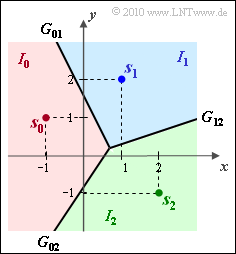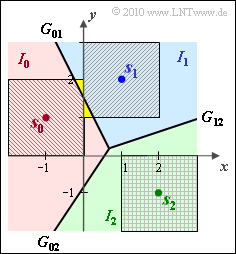Difference between revisions of "Aufgaben:Exercise 4.08Z: Error Probability with Three Symbols"
| Line 2: | Line 2: | ||
{{quiz-Header|Buchseite=Digital_Signal_Transmission/Approximation_of_the_Error_Probability}} | {{quiz-Header|Buchseite=Digital_Signal_Transmission/Approximation_of_the_Error_Probability}} | ||
| − | [[File:P_ID2037__Dig_Z_4_8.png|right|frame|Decision regions with $M = 3$ | + | [[File:P_ID2037__Dig_Z_4_8.png|right|frame|Decision regions with $M = 3$]] |
The diagram shows exactly the same signal space constellation as in [[Aufgaben:Exercise_4.08:_Decision_Regions_at_Three_Symbols|"Exercise 4.8"]]: | The diagram shows exactly the same signal space constellation as in [[Aufgaben:Exercise_4.08:_Decision_Regions_at_Three_Symbols|"Exercise 4.8"]]: | ||
| − | * the $M = 3$ possible transmitted signals, viz. | + | * the $M = 3$ possible transmitted signals, viz. |
:$$\boldsymbol{ s }_0 = (-1, \hspace{0.1cm}1)\hspace{0.05cm}, \hspace{0.2cm} | :$$\boldsymbol{ s }_0 = (-1, \hspace{0.1cm}1)\hspace{0.05cm}, \hspace{0.2cm} | ||
\boldsymbol{ s }_1 = (1, \hspace{0.1cm}2)\hspace{0.05cm}, \hspace{0.2cm} | \boldsymbol{ s }_1 = (1, \hspace{0.1cm}2)\hspace{0.05cm}, \hspace{0.2cm} | ||
| Line 15: | Line 15: | ||
| − | The two axes of the | + | The two axes of the two-dimensional signal space are simplistically denoted here as $x$ and $y$; actually, $\varphi_1(t)/\sqrt {E}$ and $\varphi_2(t)/\sqrt {E}$ should be written for these, respectively. |
These decision boundaries are optimal under the two conditions: | These decision boundaries are optimal under the two conditions: | ||
* equal probability symbol probabilities, | * equal probability symbol probabilities, | ||
| − | |||
| + | * circularly–symmetric PDF of the noise (e.g. AWGN). | ||
| − | In contrast, in this exercise we consider a two–dimensional uniform distribution for the noise PDF: | + | |
| + | In contrast, in this exercise we consider a two–dimensional uniform distribution for the noise PDF: | ||
:$$\boldsymbol{ p }_{\boldsymbol{ n }} (x,\hspace{0.15cm} y) = | :$$\boldsymbol{ p }_{\boldsymbol{ n }} (x,\hspace{0.15cm} y) = | ||
\left\{ \begin{array}{c} K\\ | \left\{ \begin{array}{c} K\\ | ||
| Line 30: | Line 31: | ||
*Such an amplitude-limited noise is admittedly without any practical meaning. | *Such an amplitude-limited noise is admittedly without any practical meaning. | ||
| − | |||
| − | |||
| + | *However, it allows an error probability calculation without extensive integrals, from which the principle of the procedure can be seen. | ||
| − | + | Notes: | |
* The exercise belongs to the chapter [[Digital_Signal_Transmission/Approximation_of_the_Error_Probability|"Approximation of the Error Probability"]]. | * The exercise belongs to the chapter [[Digital_Signal_Transmission/Approximation_of_the_Error_Probability|"Approximation of the Error Probability"]]. | ||
Revision as of 17:53, 28 July 2022
The diagram shows exactly the same signal space constellation as in "Exercise 4.8":
- the $M = 3$ possible transmitted signals, viz.
- $$\boldsymbol{ s }_0 = (-1, \hspace{0.1cm}1)\hspace{0.05cm}, \hspace{0.2cm} \boldsymbol{ s }_1 = (1, \hspace{0.1cm}2)\hspace{0.05cm}, \hspace{0.2cm} \boldsymbol{ s }_2 = (2, \hspace{0.1cm}-1)\hspace{0.05cm}.$$
- the $M = 3$ decision boundaries
- $$G_{01}\text{:} \hspace{0.4cm} y \hspace{-0.1cm} \ = \ \hspace{-0.1cm} 1.5 - 2 \cdot x\hspace{0.05cm},$$
- $$G_{02}\text{:} \hspace{0.4cm} y \hspace{-0.1cm} \ = \ \hspace{-0.1cm} -0.75 +1.5 \cdot x\hspace{0.05cm},$$
- $$G_{12}\text{:} \hspace{0.4cm} y \hspace{-0.1cm} \ = \ \hspace{-0.1cm} x/3\hspace{0.05cm}.$$
The two axes of the two-dimensional signal space are simplistically denoted here as $x$ and $y$; actually, $\varphi_1(t)/\sqrt {E}$ and $\varphi_2(t)/\sqrt {E}$ should be written for these, respectively.
These decision boundaries are optimal under the two conditions:
- equal probability symbol probabilities,
- circularly–symmetric PDF of the noise (e.g. AWGN).
In contrast, in this exercise we consider a two–dimensional uniform distribution for the noise PDF:
- $$\boldsymbol{ p }_{\boldsymbol{ n }} (x,\hspace{0.15cm} y) = \left\{ \begin{array}{c} K\\ 0 \end{array} \right.\quad \begin{array}{*{1}c}{\rm for} \hspace{0.15cm}|x| <A, \hspace{0.15cm} |y| <A \hspace{0.05cm}, \\ {\rm else} \hspace{0.05cm}.\\ \end{array}$$
- Such an amplitude-limited noise is admittedly without any practical meaning.
- However, it allows an error probability calculation without extensive integrals, from which the principle of the procedure can be seen.
Notes:
- The exercise belongs to the chapter "Approximation of the Error Probability".
- To simplify the notation, the following is used:
- $$x = {\varphi_1(t)}/{\sqrt{E}}\hspace{0.05cm}, \hspace{0.2cm} y = {\varphi_2(t)}/{\sqrt{E}}\hspace{0.05cm}.$$
Questions
Solution
(1) The volume of the 2D PDF must give $p_n(x, y) =1$, that is:
- $$2A \cdot 2A \cdot K = 1 \hspace{0.3cm}\Rightarrow \hspace{0.3cm} K = \frac{1}{4A^2}\hspace{0.05cm}.$$
- With $A = 0.75$ ⇒ $2A = 3/2$, we get $K = 4/9 \ \underline {=0.444}$.
(2) In the accompanying graph, the noise component $\boldsymbol{n}$ is plotted by the squares of edge length $1.5$ around the 2D signal space points $\boldsymbol{s}_i$.
- It can be seen that no decision boundary is exceeded by noise components.
- It follows: The symbol error probability is $p_{\rm S}\ \underline { \equiv 0}$ under the conditions given here.
(3) Statements 2 and 4 are correct, as can be seen from the graph below:
- The message $m_2$ cannot be falsified because the square around $\boldsymbol{s}_2$ lies entirely in the lower right quadrant and thus in the decision area $I_2$.
- Likewise, $m_2$ was sent with certainty if the received value lies in decision area $I_2$.
The reason: none of the squares around $\boldsymbol{s}_0$ and $\boldsymbol{s}_1$ extends into the area $I_2$. - $m_0$ can only be falsified to $m_1$. The (conditional) falsification probability is equal to the ratio of the areas of the yellow triangle (area $1/16$) and the square (area 4):
- $${\rm Pr}({ \cal E}\hspace{0.05cm}|\hspace{0.05cm} m_0 ) = \frac{1/2 \cdot 1/2 \cdot 1/4}{4}= {1}/{64} \hspace{0.05cm}.$$
- For symmetry reasons, equally:
- $${\rm Pr}({ \cal E}\hspace{0.05cm}|\hspace{0.05cm} m_1 ) = {\rm Pr}({ \cal E}\hspace{0.05cm}|\hspace{0.05cm} m_0 )={1}/{64} \hspace{0.05cm}. $$
(4) For equal probability symbols, we obtain for the (average) error probability:
- $$p_{\rm S} = {\rm Pr}({ \cal E} ) = {1}/{3} \cdot \big [{\rm Pr}({ \cal E}\hspace{0.05cm}|\hspace{0.05cm} m_0 ) + {\rm Pr}({ \cal E}\hspace{0.05cm}|\hspace{0.05cm} m_1 )+{\rm Pr}({ \cal E}\hspace{0.05cm}|\hspace{0.05cm} m_2 )\big ]$$
- $$ \Rightarrow \hspace{0.3cm} p_{\rm S} = {\rm Pr}({ \cal E} ) = {1}/{3} \cdot \left [{1}/{64} + {1}/{64} + 0 )\right ]= \frac{2}{3 \cdot 64} = {1}/{96}\hspace{0.1cm}\hspace{0.15cm}\underline {\approx 1.04 \%} \hspace{0.05cm}.$$
(5) Now we obtain a smaller average error probability, viz.
- $$p_{\rm S} = {\rm Pr}({ \cal E} ) = {1}/{4} \cdot {1}/{64} + {1}/{4} \cdot {1}/{64}+ {1}/{2} \cdot0 = {1}/{128}\hspace{0.1cm}\hspace{0.15cm}\underline {\approx 0.78 \% } \hspace{0.05cm}. $$
(6) Correct is YES:
- For example, $I_1$: first quadrant, $I_0$: second quadrant, $I_2 \text{:} \ y < 0$ would give zero error probability.
- This means that the given bounds are optimal only in the case of circularly symmetric PDF of the noise, for example, the AWGN channel.


